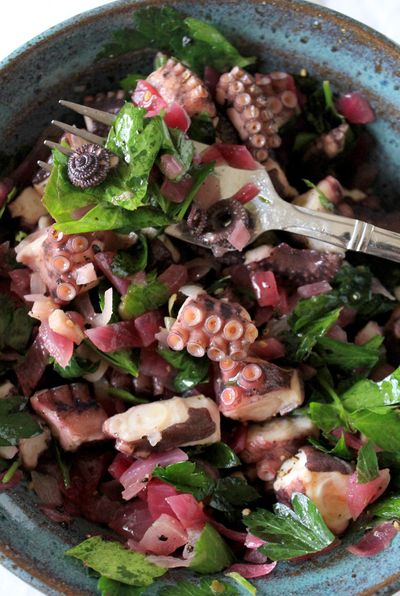Octopus - disarmingly delicious
This cephalopod mollusk offers a light, supple base for a delicious salad

With its slithery, suction cup-covered tentacles, bulbous head and beady eyes, an octopus might seem like a less-than-appealing ingredient.
Certainly, many find the eight-armed sea creature to be an acquired taste and texture. Some use words like “rubbery” or “chewy” and “slimy” as reasons why they won’t touch, or even try, the stuff. But when cooked properly, the meat is supple with a mild, slightly salty flavor.
Common cuisine on islands and coastlines from Polynesia and Japan to Greece and the Mediterranean, octopus provides a versatile base for a lean seafood salad. It’s light, rich in protein and low in calories – perfect, warm-weather food.
The flavor is fresh and delicate. It reminds me of the sea, sun and ancient light-filled and limestone-lined streets of Dalmatia, the southern tine of Croatia.
Anchored by walled, seaside cities – Zadar to the north, Dubrovnik to the south – Dalmatia hugs the eastern edge of the Adriatic Sea. My all-time favorite octopus salad can be found throughout the region. But it particularly takes me back in taste and memory to Korcula, the small, walled port town on the island of the same name. It’s a pine-covered place with red-tiled roofs, ancient fortifications, olive groves and inlets.
Besides octopus, the ingredients of the salad are simple: lemon, onion, garlic, Italian flat-leaf parsley, salt, pepper and olive oil. I think it tastes even better with olive oil from the island.
When the last tiny, tender tendril of octopus is gone, I’ll use a crusty piece of bread to mop of the remaining briny oil, infused with herbs and a hint of the sea.
Dalmatian Octopus Salad (Dalmatinska Salata od Hobotnice)
1 large octopus, cleaned and rinsed (fresh or thawed)
1 bay leaf
1 medium red onion, thinly sliced
1/4 cup plus 1 tablespoon olive oil, divided
3 to 4 cloves garlic, minced
1 bunch chopped parsley
Juice of 1 lemon
2 tablespoons capers (optional)
Lemon slices, for garnish (optional)
Cherry tomatoes, for garnish (optional)
Pitted kalamata or other oil-cured black olives for garnish (optional)
salt and pepper to taste
Rinse octopus under running water. Add bay leaf to large pot of water, and bring to a boil. Add octopus and simmer for about 20 minutes or until octopus becomes tender. Let it cool in its cooking water. Cut off the curly ends, then chop the rest of the tentacles into ½-inch pieces. Place both the ends and pieces into a salad bowl.
Sauté onion until glossy in a pan or skillet with 1 tablespoon olive oil. Add garlic, and sauté for another 1 to 2 minutes. Remove from heat and cool.
Add onion, garlic, parsley, lemon juice, remaining olive oil and capers to the octopus in the salad bowl. Season with salt and pepper. Mix well. Garnish with tomatoes, olives and lemon slices – or all three or any combination of them – if desired. Serve with crusty bread.
Notes: Some swear by cooking octopus with wine corks in the water, saying the method somehow softens the sea creature. Others advise boiling it for two or three hours – or longer. Still others insist on pounding the creature with a meat mallet or slamming it against a hard surface, like seaside docks.
I’ve found if you boil an octopus for about 20 minutes it will become tender. But if you leave it in too long, it will toughen up, requiring hours on the stovetop to become tender again.
Not all supermarkets in the Inland Northwest carry octopus. I found large and baby octopuses at Williams Seafood Market and Wines, 2118 N. Ruby St. in Spokane.